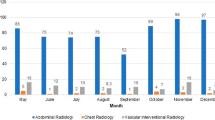Abstract
Purpose
To retrospectively analyze our interventional radiology outpatient clinics (IROC) for referral patterns, impact on interventional practice, and patient satisfaction.
Materials and Methods
Consultations performed between 2011 and 2019 were extracted. The two consecutive years with the highest number of consultations (n2018 = 1426; n2019 = 1595) were compared for unattended consultations (i.e., scheduled consultations with patients not showing-up); initial/follow-up consultations; hospital clinician/general practitioner referrals; initial consultations with radiologists not recommending interventions; procedural conversion rate (PCR; i.e., No. initial consultations resulting in interventions over the total number of initial consultations performed for the same clinical indication). A survey was conducted in 159 patients to determine their satisfaction.
Results
Consultations increased from 2011 to 2019 by 130%. In 2018–2019, the number of unattended consultations was stable (7.0% vs 6.6%; P = .68). The referrals were for back pain (42.2%), interventional oncology (40.5%), and arteriovenous malformations (9.0%). For back pain, in 2019, there were fewer consultations with radiologists not recommending interventions and increased PCR compared to 2018 (11.9% vs. 17.7%; 88.1% vs. 82.3%; respectively; P = .01). For interventional oncology, follow-up consultations and general practitioner referrals increased in 2019 compared to 2018 (43.0% vs 35.3%; P = .01; 24.4% vs. 12.7%; P < .01; respectively). No other changes were noted. Cumulative 2018–2019 PCR was ≥ 85.4%. 99.2% responders highly appreciated their IROC experience. Quality of secretarial and medical services were the main aspects evaluated to rate the experience with IROC.
Conclusion
IROC results in high PCR. Recent changes in referral/impact on IR practice were noted with patients referred for back pain and interventional oncology.
Level of Evidence IV
Level 4, Case Series.



Similar content being viewed by others
References
Dotter CT, Judkins MP, Rösch J. Transluminal angioplasty in arteriosclerotic obstruction of the lower extremities. Med Times. 1969;97(7):95–108.
Baum RA, Baum S. Interventional radiology: a half century of innovation. Radiology. 2014;273(2 Suppl):S75-91.
Baerlocher MO, Owen R, Poole A, et al. Interventional radiology deserves formal recognition as a distinct medical subspecialty: a statement from the Canadian interventional radiology association. J Vasc Interv Radiol. 2008;19(1):9–12.
Zener R, Demers V, Bilodeau A, et al. Clinical IR in Canada: the evolution of a revolution. J Vasc Interv Radiol. 2018;29(4):524-530.e2.
Khan N, Murphy TP, Soares GM, et al. Clinical services provided by interventional radiologists to medicare beneficiaries in the United States, 2000–2003. J Vasc Interv Radiol. 2005;16(12):1753–7.
Edalat F, Lindquester WS, Gill AE, et al. The effects of expanding outpatient and inpatient evaluation and management services in a pediatric interventional radiology practice. Pediatr Radiol. 2017;47(3):321–6.
Abboud SE, Soriano S, Abboud R, et al. The radiologist is in, but was it worth the wait? Radiology resident note quality in an outpatient interventional radiology clinic. Curr Probl Diagn Radiol. 2017;46(3):177–80.
Palmer WE. Spinal injections for pain management. Radiology. 2016;281(3):669–88.
Tsoumakidou G, Too CW, Koch G, et al. CIRSE guidelines on percutaneous vertebral augmentation. Cardiovasc Interv Radiol. 2017;40(3):331–42.
Garnon J, Doré B, Auloge P, et al. Efficacy of the vertebral body stenting system for the restoration of vertebral height in acute traumatic compression fractures in a non-osteoporotic population. Cardiovasc Interv Radiol. 2019;42(11):1579–87.
Cohen SP, Doshi TL, Constantinescu OC, et al. Effectiveness of lumbar facet joint blocks and predictive value before radiofrequency denervation: the facet treatment study (FACTS), a randomized controlled clinical trial. Anesthesiology. 2018;129(3):517–35.
Cazzato RL, Bonichon F, Buy X, et al. Over ten years of single-institution experience in percutaneous image-guided treatment of bone metastases from differentiated thyroid cancer. Eur J Surg Oncol. 2015;41(9):1247–55.
Dreyfuss LD, Wells SA, Best SL, et al. Development of a risk-stratified approach for follow-up imaging after percutaneous thermal ablation of sporadic stage one renal cell carcinoma. Urology. 2019;134:148–53.
Lage A, Crombet T. Control of advanced cancer: the road to chronicity. Int J Environ Res Public Health. 2011;8(3):683–97.
Duszak R, Borst RF. Clinical services by interventional radiologists: perspectives from medicare claims over 15 years. J Am Coll Radiol. 2010;7(12):931–6.
Funding
This study was not supported by any funding.
Author information
Authors and Affiliations
Corresponding author
Ethics declarations
Conflict of interest
The authors declare that they have no conflict of interest.
Informed Consent
This study has obtained IRB approval from University Hospital of Strasbourg and the need for informed consent was waived.
Human or Animal Rights
This article does not contain any studies with animals performed by any of the authors.
Additional information
Publisher's Note
Springer Nature remains neutral with regard to jurisdictional claims in published maps and institutional affiliations.
Rights and permissions
About this article
Cite this article
Cazzato, R.L., de Rubeis, G., de Marini, P. et al. Interventional Radiology Outpatient Clinics (IROC): Clinical Impact and Patient Satisfaction. Cardiovasc Intervent Radiol 44, 118–126 (2021). https://doi.org/10.1007/s00270-020-02677-1
Received:
Accepted:
Published:
Issue Date:
DOI: https://doi.org/10.1007/s00270-020-02677-1




